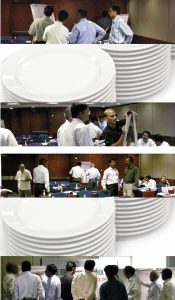By Muthiah Kasi, PE, SE, CVS-Life, FSAVE
Engineers and managers from various organizations participated in a seven day workshop at the Novotel Hotel in Hyderabad, India. As the VE training progressed, the team started to appreciate its application in daily activities. During a lunch break on the third day it was evident that the workshop was beginning to really penetrate the minds of participants. One person observed the weight of the plates that were used at the buffet-style lunch. Over the next three days, the conversation expanded to measure the value of the plates used. The following briefly describes this discussion.
 Person X: The caterer didn’t consider the use of the plates when planning this buffet-style lunch.
Person X: The caterer didn’t consider the use of the plates when planning this buffet-style lunch.
Person Y: You are right! They didn’t consider the needs of the users. If the planned meal was a plated lunch, meaning the user didn’t have to carry the plate at all, this plate would have sufficed. For a buffet-style lunch where the user stands and eats, these plates are too heavy. The need of the user is to have a lighter weight plate.
Person Z: Keep in mind they have other users who have conflicting needs. The management wants the plates to last longer, and a heavy plate is likely more durable. Also, the maintenance people want a plate that doesn’t break when they place them in the dishwasher.
Instructor: Based on this discussion, the question should be asked is “Does the heavy plate have a higher value or a lower value?”
Person X: It depends upon the decision makers.
The key to defining value is to look at all the activities in the eyes of the users, owners and stakeholders. The fact that the team began thinking in these terms at lunch demonstrates their understanding of this process. VE techniques can be most successful when people engage enthusiastically in the process.
